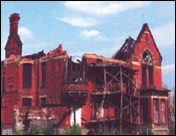Restoring Community Self Determination
Each issue of The Engaged Scholar Magazine will feature a brief "think piece" about the theory and practice of engaged scholarship.
For this issue, Associate Provost for University Outreach and Engagement Hiram E. Fitzgerald builds on the issue's theme of healthy families, but broadens the lens to look at what makes for healthy neighborhoods and communities.
Like families, communities can be characterized on a spectrum of health from "at risk" to "thriving." Researchers can assist communities and neighborhoods in restoring and transforming themselves using innovative capacity building and community transformation models.
Hiram E. Fitzgerald
Associate Provost for University Outreach and Engagement
During the past century, the world-wide transition from rural to urban life accelerated at an unprecedented rate. Humanity can now be characterized as an urban species. Eighty-three percent of all people reside in urban areas. Eighty-five percent of all jobs are created in urban areas.
Yet there is a concern about the quality of life in our cities. Many neighborhoods, and indeed whole cities, face complex and difficult issues. All too often "at risk" neighborhoods are characterized by concentrated poverty, racial separation and isolation, low levels of academic achievement among children, a poor economic base for industry, weak social ties, and a sense of powerlessness and isolation. Lack of self-sufficiency and self-determination undermines restoration of neighborhood, community, and perhaps, American democratic values.
While no single approach can magically transform "at risk" communities into "thriving" ones, some models are approaching community change from a new and promising perspective. These models, referred to as comprehensive community-building initiatives (CBIs) or community-based participatory research (CBPR), recognize that change in individuals is fundamental to development of community self-determination and transformation.


From "at risk"...to "thriving"
CBIs focus on the core components of social networks—engagement in communities at the personal, social, educational, and economic levels. They involve building self-determination, self-confidence, personal skills, relationships among and between neighborhoods and institutions, a sense of power over personal and neighborhood life, and access to and control of resources.
Thus, transforming communities requires transformation of neighborhoods, which in turn requires transformation in residents by creating a sense of community, organized participation, formal and informal neighboring, and a belief in collective efficacy (the ability to achieve change). All of these are foundational to creating a sense of well-being, both individually and collectively.
Such changes in attitudes and behavior are achieved by participation in block, neighborhood, and building associations; faith-based community service or advocacy committees; and coalitions, school-based associations, and other grass-roots community organizations.
As noted by John W. Gardner (2006), psychologist, founder of Common Cause, and former Secretary of Health, Education, and Welfare, "The surest cure for the sense of powerlessness that afflicts so many citizens today is to take action on the problems of their own communities, restoring belief in their capacity to make a difference."
Comprehensive community-building initiatives (CBIs) and self-determination approaches to community change research are effective approaches to enable citizens, neighborhoods, and communities to restore their belief that change is possible. Such programs require commitment from funding agencies, universities, and other societal institutions to partner with citizens over significant time periods to enhance the quality of community life.
Comprehensive Community-Building Initiatives (CBIs)
Some principles and guidelines:*
- Community members and organizations working together can be catalysts for change.
- Communities are complex and dynamic. They must be analyzed and evaluated on multiple, systemic levels.
- Top-down approaches do not empower communities and do not lead to change in individual behavior.
- Evaluation must involve all segments of the community and its external partners, and be based on a continuous quality improvement model.
- Community action plans must specify desired outcomes so that progress can be assessed and programs can be modified to fit desired outcomes.
- Evaluation should be part of all community change processes from the beginning so that continuous feedback can be provided to individuals, planning teams, and networks as programs are developed, implemented, and corrected over time.
- Initiatives must invest in programmatic efforts to build self-determination through leadership development, resident organization and advocacy, and creation of a sense of agency, power, and community.
- Residents must be given incentives, such as neighborhood mini grants, to become part of change efforts.
References
Foster-Fishman, P. G., Cantillon, D., Pierce, S. J., & Van Egeren, L. (In press). Building an active citizenry: The role of neighborhood problems, readiness, and capacity for change. American Journal of Community Psychology.
Foster-Fishman, P. G., Fitzgerald, K., Brandell, C., Nowell, B., Chavis, D., & Van Egeren, L. (In press). Mobilizing residents for action: The role of small wins and strategic supports. American Journal of Community Psychology.
Gardner, J. W. (1994, September). There is more than a ray of hope for America's future: Rebuilding America's sense of community. Journal for Quality and Participation, 17(5). Retrieved July 8, 2007 from www.worldtrans.org/qual/americancommunity.html
- Written by Hiram E. Fitzgerald, University Outreach and Engagement